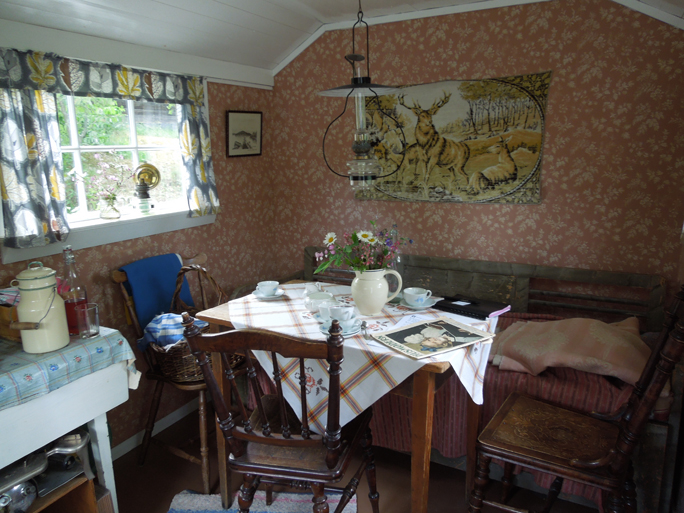Tanto – A Hillside Allotment in Stockholm
Visited June 12, 2014 with the Lakeland Horticulture Society
The green spaces and public parks in Sweden that were established as early as the mid-1800's, are the foundation of the recreational spaces in the centers of towns and cities that are an important part of Sweden's heritage and culture. Parks can be landscape gardens in which play, sport and recreation are integrated.
Stockholm, a city that sits on 14 islands surrounded by water, has 26 city parks. The Hotel Zinkensdamm (where our group had our final 2 nights stay), is on Södermalm, Stockholm’s southern island adjacent to the popular public park Tantolunden. This park is popular for seasonal sports and public festivals. Included in this park's green landscape is the Tanto gardens; one hundred and eleven individual allotment plots on a high hill. Each plot is stamped with its owners personality with a miniature cottage surrounded by vegetables beds often combined with a display of ornamental flowers.

Numerous styles of gardening were displayed in the plots including formal gardens, kitchen, vegetable, and country cottage.



The use of rocks and boulders from the hillside were incorporated into an attractive garden landscape. Several plots at Tanto included mature fruit trees.


Sweden's first allotment (or kolonilotter as the garden compounds are called in Sweden) was established in Malmö in 1895. Stockholm followed in 1904 after city authorities were inspired by Swedish politician Anna Lindhagen's book about Copenhagen's allotment gardens. In 1906 Lindhagen established the first allotment society in Stockholm to oversee the various allotments that were in the countryside at that time for the use of Stockholm's poor to grow food in fresh country air. The Swedish Federation of Leisure Gardening was established in 1921 and currently oversees 300 local societies in Sweden.
The Tanto allotments were laid out in 1915 when there was a serious shortage of food and near starvation in the cities during the 1st World War. A series of wooden board steps were built into a hillside of boulders. Working class families were allotted plots of ground for growing potatoes and common vegetables on the hillside. Originally rain huts were put up followed by sheds to house garden equipment.
By the 1920's uniformity was required by the Allotment Society which created models for the design and paint colors (red, white, yellow or dark green) of wooden cottages. These miniature cottages (as seen at the Skansen Open Air Living Museum), were furnished with a small cooking stove, tables and chairs for meals and a daybed incorporated into the furnishings for weekend overnights. A space for essential gardens tools and boots would be close to the front door.



In the 1940's the vegetable growers would include flowers and apple trees in their plots. Herbs and berries would also enter the mix of garden fare.




Uniformity of the wooden cottages were relaxed in the 1960's allowing individually designed and larger living cottages to be built. Two rooms allow a kitchen with small appliances, living space plus storage for essential garden tools. Touches of creativity from the bric-a-brac attached to the wooden siding of cottages to garden art as ornamental decorations were added. In the 1970's electricity and phone lines were added to the cottages. Cold water is provided to the cottages by a hose and there are communal bathroom facilities.

My visit was in the early evening on a weekday when gardening activity was minimal. Standing on the top of the hill the roof tops of the high-rises of the city were visible. Now the Tanto is the the answer for those city dwellers to have a weekend garden retreat; a home away from home from spring till frost.

The evening was quiet but a sense of community was visible. Dry gravel pathways with street signs provided directions for the visitor searching for a numbered cottage.

Picket fences that surround individual plots are short in height providing visibility for the passerby to enjoy the garden and ease for neighbors to spend time talking over the fence.

Patios in the gardens with outdoor table and chairs were common. At the end of August the Tanto gardeners have a community harvest festival in Tantolunden park.

Tanto is no longer an allotment for the poor potato grower. Tanto (and other similar city allotment spaces) have become an alternative to the country Swedish summer house. There is waiting list though of over 350 city dwellers for Tanto with a wait time up to 20 years to obtain a plot and cottage. An annual fee close to $2,000 is charged for ownership of a Tanto space with the local society deciding on the price of the house. The city of Stockholm has approximately 10,000 individual allotment garden plots in 150 areas in the city involving about 24,000 people.

It was on my visit to the Skansen Open Air Living Museum in Stockholm that I found original cottages of Tanto from 1920 and 1940 along with planted gardens of those two decades. Included as part of Sweden's five centuries of history at the museum, it is an indication of the importance that allotment gardens have contributed to the health of Sweden's society and its individuals since 1895. The colorful June garden mix on a hillside in Södermalm above the Årstaviken Bay, one of Stockholm's oldest kolonilotter (and Sweden's largest) is a testament to a collective and productive use of green spaces to benefit members of its society.

Photos by Deborah McMillin